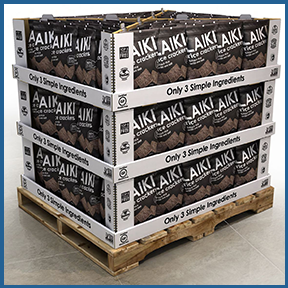
Solving Pouch Packaging Challenges
Packaging products in pouches in preparation for distribution, shipping, and display comes with its set of challenges. Kaufman Engineered Systems automation systems tackle these issues head-on, providing precise pick-and-place capabilities to ensure each pouch is placed correctly and gently, reducing the risk of damage. Customizable grippers allow the systems to handle a wide range of pouch sizes and types. Plus, our systems offer high-speed operations, significantly increasing production capacity.
At KES, we don't just provide robotic automation systems; we deliver solutions that drive your business forward. Explore this page to learn more about the challenges of packaging and handling products in pouches and how we can help you overcome them.
Understanding the Challenges of Packaging Pouches

At Kaufman, we've spent years honing our expertise in creating systems that adeptly manage products in pouches for our clients - and our solutions extend beyond just the palletizing/depalletizing aspect of the packaging process. We integrate additional functionalities into these systems to guarantee a reliable and uniform outcome while avoiding damage. Here are some of the challenges that need to be tackled when dealing with products in pouches:
Palletizing and Depalletizing: A Balancing Act
it comes to palletizing - the process of stacking goods on a pallet, and depalletizing - the process of unstacking, the challenges are many. These include varying pallet sizes, shapes, weights, and differing palletization needs and configurations. Furthermore, these processes can be labor-intensive, leading to high operational costs.
Pouches add an extra layer of complexity to these processes. Unlike boxes or rigid containers, pouches are flexible, which makes them prone to shifting or toppling if not stacked properly. Moreover, their lightweight nature means they can be easily displaced during transit, leading to further complications during the depalletizing process.
Conveying: The Need for Speed and Precision
Conveying, or the act of moving goods from one point to another within a facility is another critical step in the manufacturing and distribution process. Here, speed and precision are crucial. Too fast, and pouches risk being damaged or misplaced. Too slow, and it could lead to bottlenecks in the production line.
Transition points between conveyors represent another challenge. If not managed carefully, pouches can be damaged or misoriented at these junctures, causing disruptions in subsequent processes like labeling or sealing.
Securing: Holding It All Together
Securing products for transportation or storage is the final step in the process, but it is by no means the least challenging. The goal here is to ensure that the products are safely locked in place, but achieving this with pouches can be tricky.
Pouches, due to their flexibility and lightweight nature, can be difficult to secure effectively. Too much pressure can cause them to burst or tear, while too little might not hold them in place, leading to potential damage during transportation.
Despite these challenges, there are solutions at hand. Today, automated systems designed to handle these processes offer a way forward. These systems use advanced robotics and artificial intelligence to deliver high-speed, precise handling of products, reducing labor costs and enhancing overall efficiency.
Understanding these challenges is the first step toward finding effective solutions. With the right technology and strategies in place, businesses can overcome these hurdles and ensure smooth, efficient operations.
Despite these challenges, technological advancements have paved the way for effective solutions. Kaufman Engineered Systems designs and builds systems that successfully address these issues, increasing productivity and efficiency while reducing product damage and improving worker safety. Contact Us for more information!
